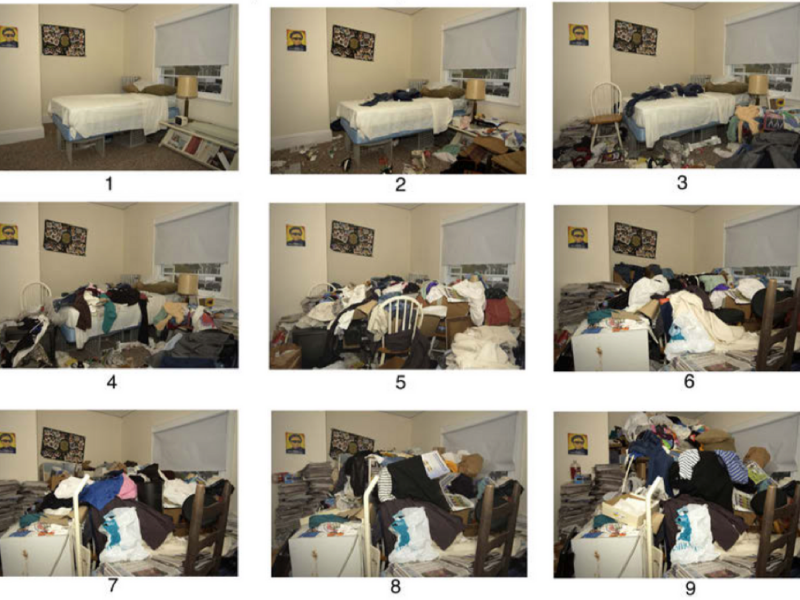There’s help for hoarding
Hoarding Disorder (HD) is a mental health issue that individuals can get help for. Frequently, a family member will need to initiate this help, as people with HD may not have awareness or insight into the consequences of their behaviour. Occupational therapists (OTs) trained to address hoarding behaviour, like me, can use assessment skills and strategies to develop and implement a plan focussed on your loved one’s individual needs and goals. We can collaborate on how best to reach and connect with your family member in a non-judgmental manner.
What is Hoarding Disorder (HD)?
Those who hoard have true difficulty in getting rid of possessions, regardless of their value or usefulness, and efforts to discard these items and not acquire more of them can cause significant distress. Hoarding behaviour can result in a living space that is cluttered and compromised. This increases risk of falls, fire and infestation, not to mention social isolation and impairment in day-to-day life. For those in a landlord-tenant situation, hoarding can also lead to homelessness.
In Canada, between 2 and 6% of the population is diagnosed with HD – this is a high number! The onset is usually in adolescence (68%) and becomes progressively disabling in adulthood.1 The visible signs that an individual has HD can be pretty obvious – the large number of possessions makes it hard to walk through rooms or use them for their intended purpose. Or perhaps a family member keeps parts of their home off limits or tries to keep you out altogether. In order to obscure their hoarding, they may not attend to needed home repairs, not wanting a repair person to see their space or being unable to clear a path to have repairs done.
How can an occupational therapist (OT) help?
Although OTs do not diagnose, OTs trained to work with hoarding behaviour have a variety of tools that will help measure and understand an individual’s hoarding behaviour, its severity, possible underlying causes, and distress the individual is experiencing. OTs are skilled professionals that use evidence-based techniques that look at the ‘whole’ person – their physical and mental wellness, their environment and what they need and want to do each day. In this way, an OT can not only address hoarding behaviour, but also improve one’s ability to function for holistic, long-term success.
1. It starts with establishing a relationship:
Working with an OT starts with establishing a good rapport, learning about the individual and their goals, then moving forward to develop and implement a mutually agreed-to plan to address hoarding and/or reduce the negative consequences of hoarding behaviour. It all depends on an individual’s readiness for change. Forced disposal of someone’s possessions is not an effective strategy to deal with hoarding and causes unnecessary trauma. Individuals ready to address their hoarding behaviours can expect 20 sessions with an OT trained to address HD, or sometimes many more, as empowering hoarding behaviour change is a gradual process based on exposing the individual with HD to intervention strategies over a period of time.
Following a trauma-informed approach, the individual with HD is involved and maintains control of the process by helping set the ground rules for the intervention and making decisions about objects.
OT interventions do not include prescribing medication, they provide non-pharmacologic treatment. An OT will work with other health care providers, however, if drug therapy aligns with an individual’s needs and should be built into their plan.
Every plan is customized based on the specific needs and preferences of the individual with HD and their family.
2. Your loved one with HD will be assessed over a series of sessions. Here is a sampling of the assessments that an OT might provide:
The ‘Clutter Image Rating’. These nine images are commonly used as an indicator of how extreme the clutter is in the individual’s living space, to start the conversation about perceptions of clutter and start gauging motivation to make a change. If there is a landlord complaint about a tenant’s clutter, it is generally considered reasonable if the level of clutter is a 4 or higher. The trigger for intervention can vary if the clutter involves odours or infestations.
Clutter Image Rating: Bedroom
Please select the photo that most accurately reflects the amount of clutter in your room.
Source: Frost, Steketee, Tolin, & Renaud, 2007.
The ‘Activities of Daily Living for Hoarding’. This questionnaire assesses 29 items that cover how the individual with HD sees their ability to take care of themselves, their living conditions and their level of safety. The portion of the tool below helps identify any urgent safety or tenancy issues that the individual with HD is currently living with:
Source: Frost, Ruby & Shuer, 2012
The ‘Savings Cognition Inventory’. This is another questionnaire that poses 24 questions that help the OT get a sense of an individual’s beliefs underlying their hoarding behaviour. This tool facilitates valuable awareness-raising regarding the meaning and purpose of hoarding behaviour that can help in individualizing a plan for changing behaviours. Here is an excerpt:
Source: Steketee, G., Frost, R.O., & Kyrios, M. (2003).
3. Your OT will work with you and your loved one with HD to customize and implement a plan. This phase of your relationship is referred to as ‘intervention’, which really means taking next steps in supporting your loved one to better manage their hoarding behaviours. Here are some examples of OT interventions:
Motivational Interviewing (MI). This set of techniques aims to create the motivation to change by posing questions that help them recognize and close the gap between what their life is like now, and what they would like it to be. MI techniques are employed over a period of time and involve:
recognizing a meaningful problem (one or more specific harms related to hoarding behaviours)
associating the hoarding problem with some level of distress that the individual is experiencing
identifying the individual’s desire to change
identifying the individual’s degree of optimism about a successful outcome.
Cognitive Behaviour Therapy (CBT). This set of techniques can help individuals with HD to examine the way they think and behave, with the goal of changing their behaviour over time, with support. Specifically, for those with HD, the goal of CBT is to reframe the way the individual thinks and behaves regarding acquiring too many things and/or not being able to discard them. CBT techniques for people with HD can also include the use of behavioural experiments and exposure therapy as a means of testing thoughts that are getting in the way of changing behaviour.
Decluttering, Non-Acquiring and Behaviour Maintenance Skill Development. This part of the intervention involves breaking down, adapting and practicing skills related to changing hoarding behaviour, with support. Such skills include decision making, organizing, time estimation, establishing routines, and coping with unpleasant emotions.
To illustrate what it can look like to address hoarding behaviour, I will refer to a fictional client, Sam, an individual with HD who felt committed to making behavioural changes to better manage her hoarding disorder. She was in trouble with her landlord, partly because of the strong odours coming from her apartment.
To support Sam in taking next steps we:
took pictures of her home at the beginning of our relationship, our ‘before’ picture, and together completed the assessment tools listed above.
identified and prioritized goals for undertaking the work – the most important being to maintain tenancy and a secondary goal to be able to cook more easily at home.
started with weekly decluttering sessions in the kitchen with a first step to clear the stove and sink area. Then moved systematically into other priority areas including a step-by-step look at her large collection of cat toys, beds, and litter boxes.
in the process of decluttering, introduced and revisited other interventions including MI and CBT and saw progress such as a reduction of possessions and a shift from negative thinking to something more positive – belief that success was possible.
introduced non-acquiring and maintenance skills to move towards sustainability of behaviour changes made.
Six months later, Sam was still housed. After seeing the progress that Sam had made in cleaning her rental unit, the landlord renewed her lease.
HD is a chronic condition, one that needs non-judgmental support from family members and others over long periods of time. Being proactive, but not forceful, with your offer of support is usually the best way forward. Would you like to connect with an OT on this topic?
The Canadian Association of Occupational Therapists (CAOT) provides a searchable national directory of occupational therapists for all Canadians to find the occupational therapy services they need. You can search Mental Health as an area of practice and seek an OT who has been trained to address hoarding.
……………………………
1. Weiss, K., & Khan, A. (2015). Hoarding, housing, and DSM-5. Journal of the American Academy of Psychiatry and Law Online, 4, 492-498, and
Tolin, D., Stevens, M., Villaviencio, A., Norberg, M., Calhoun, V., Frost, R, Pearlson, G. (2012). Neural mechanisms of decision making in hoarding disorder. Archives of General Psychiatry, 69(8), 832-841.
Occupational therapy. Making the everyday possible.




